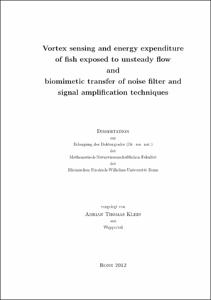Klein, Adrian Thomas: Vortex sensing and energy expenditure of fish exposed to unsteady flow and biomimetic transfer of noise filter and signal amplification techniques. - Bonn, 2014. - Dissertation, Rheinische Friedrich-Wilhelms-Universität Bonn.
Online-Ausgabe in bonndoc: https://nbn-resolving.org/urn:nbn:de:hbz:5n-34404
Online-Ausgabe in bonndoc: https://nbn-resolving.org/urn:nbn:de:hbz:5n-34404
@phdthesis{handle:20.500.11811/5808,
urn: https://nbn-resolving.org/urn:nbn:de:hbz:5n-34404,
author = {{Adrian Thomas Klein}},
title = {Vortex sensing and energy expenditure of fish exposed to unsteady flow and biomimetic transfer of noise filter and signal amplification techniques},
school = {Rheinische Friedrich-Wilhelms-Universität Bonn},
year = 2014,
month = jan,
note = {Biomimetics is a promising field of research in which natural processes and structures are transfered to technical applications. Part one and two of this work investigate the behavior and the hydrodynamic sense of fish to uncover strategies for locomotory cost reduction and navigation in unsteady flow. Fish detect unsteady flow with their lateral line organ. Trout and rudd were exposed to an unsteady flow signature caused by submerged cylinders. Trout preferred distinct three dimensional regions relative to the cylinder and showed less muscle activity than in non-preferential regions. Interestingly one of those regions had a three dimensional flow signature compared to the almost two dimensional flow pattern of a vortex street. Navigation in complex flow requires sensors and smart signal processing. This work shows that the activity of central neurons of rudd involved in the processing of hydrodynamic information correlated with unsteady flow signatures in terms of spike pattern or spike rate or both. It would be advantageous for robots to use an artificial hydrodynamic sense together with natural inspired signal processing to reduce locomotory costs and also navigate in complex hydrodynamic habitats. In sensory systems it is crucial to separate meaningful signals from noise which may occur in complex habitats. Nature has developed a stunning diversity of lateral line morphologies. The function is not well understood. Part three and four of this work investigate several lateral line morphologies with respect to noise filtering and signal amplification mechanisms. To do so an artificial lateral line sensor was used. Therefore it was possible to gain control of all parameters. An artificial lateral line design was found which significantly enhances signal to noise ratio and therefore this work uncovers the function of this natural morphological occurrence. Additionally a finite element model with fluid structure interaction was used to develop a signal enhancing design of artificial neuromasts for fabrication with microelectromechanical systems. Interestingly a similar structure occurs in nature. Last but not least in part five this work shows an eight channel artificial lateral line canal sensor available with automatic fabrication techniques.},
url = {https://hdl.handle.net/20.500.11811/5808}
}
urn: https://nbn-resolving.org/urn:nbn:de:hbz:5n-34404,
author = {{Adrian Thomas Klein}},
title = {Vortex sensing and energy expenditure of fish exposed to unsteady flow and biomimetic transfer of noise filter and signal amplification techniques},
school = {Rheinische Friedrich-Wilhelms-Universität Bonn},
year = 2014,
month = jan,
note = {Biomimetics is a promising field of research in which natural processes and structures are transfered to technical applications. Part one and two of this work investigate the behavior and the hydrodynamic sense of fish to uncover strategies for locomotory cost reduction and navigation in unsteady flow. Fish detect unsteady flow with their lateral line organ. Trout and rudd were exposed to an unsteady flow signature caused by submerged cylinders. Trout preferred distinct three dimensional regions relative to the cylinder and showed less muscle activity than in non-preferential regions. Interestingly one of those regions had a three dimensional flow signature compared to the almost two dimensional flow pattern of a vortex street. Navigation in complex flow requires sensors and smart signal processing. This work shows that the activity of central neurons of rudd involved in the processing of hydrodynamic information correlated with unsteady flow signatures in terms of spike pattern or spike rate or both. It would be advantageous for robots to use an artificial hydrodynamic sense together with natural inspired signal processing to reduce locomotory costs and also navigate in complex hydrodynamic habitats. In sensory systems it is crucial to separate meaningful signals from noise which may occur in complex habitats. Nature has developed a stunning diversity of lateral line morphologies. The function is not well understood. Part three and four of this work investigate several lateral line morphologies with respect to noise filtering and signal amplification mechanisms. To do so an artificial lateral line sensor was used. Therefore it was possible to gain control of all parameters. An artificial lateral line design was found which significantly enhances signal to noise ratio and therefore this work uncovers the function of this natural morphological occurrence. Additionally a finite element model with fluid structure interaction was used to develop a signal enhancing design of artificial neuromasts for fabrication with microelectromechanical systems. Interestingly a similar structure occurs in nature. Last but not least in part five this work shows an eight channel artificial lateral line canal sensor available with automatic fabrication techniques.},
url = {https://hdl.handle.net/20.500.11811/5808}
}






